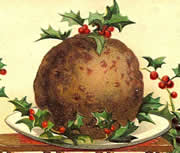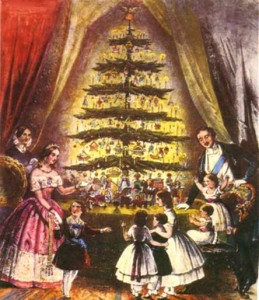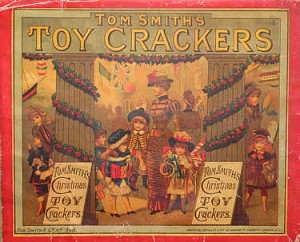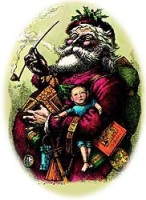Origin of Some British Christmas Traditions
The modern British Christmas consists of many different traditions. We often observe them without really knowing what they mean or where they originated from. Here’s some interetsing facts about some of them …
The Christmas Tree
The Christmas tree today is a common custom to most of us. There are many interesting connections to ancient traditions such as Egyptian and Roman customs.
The Egyptians were part of a long line of cultures that treasured and worshipped evergreens. When the winter solstice arrive, they brought green date palm leaves into their homes to symbolize life’s triumph over death.
The Romans celebrated the winter solstice with a feast called Saturnalia in honor of Saturnus, the god of agriculture. They decorated their houses with greens and lights and exchanged gifts. They gave coins for prosperity, pastries for happiness, and lamps to light one’s journey through life.
Centuries ago in Great Britain, priests called Druids used evergreens during mysterious winter solstice rituals. The Druids used holly and mistletoe as symbols of eternal life, and place evergreen branches over doors to keep away evil spirits.
Late in the Middle Ages, Germans and Scandinavians placed evergreen trees inside their homes or just outside their doors to show their hope in the forthcoming spring.
That said most scholars point to Germany as being the origin of the Christmas tree. From Germany the custom was introduced to Britain, first via Queen Charlotte, wife of George III, and then more successfully by Prince Albert during the reign of Queen Victoria. By 1841 the Christmas tree had become even more widespread throughout Britain. By the 1870s, people in the United States had adopted the custom of putting up a Christmas tree.
Turkey
Meat has always featured at the centre of traditional Christmas feasts, although it is has not always been in the form of turkey. Popular meats used for early celebratory purposes were beef, mutton, pork, peacocks and swans. King James I (1566-1625) can be thanked for the emergence of turkey as he introduced it during the seventeenth century for the important reason that it was far kinder to his delicate digestive system! Of course not everyone could afford it, and the poor had to make do with goose.
Interesting Turkey Factoids : ⇒ Turkeys originated from Mexico not Turkey. ⇒ The first meal eaten on the moon by Neil Armstrong and Buzz Aldrin was cold roast turkey.
Christmas Pudding

Figgy Pudding
Christmas pudding, or plum pudding or figgy pudding, is believed to originate from the medieval period (early 15th centuary probably) when plum pottage was served during festivities. Plum pottage was a meat broth that was made made from chopped beef or mutton, onions and perhaps other root vegetables, along with breadcrumbs and dried fruit added for thickening purposes. It was seasoned with wine and spices. This form of broth developed into a thicker pudding during the seventeenth century when pudding cloths were invented; the meat content was later removed and it became more as we know it today. The pudding became specifically associated with Christmas, rather than merely any festive occasions, when it was introduced to the Royal Christmas dinner table by Prince Albert.
Crackers
Tom Smith, a baker of wedding cakes from Clerkenwell, London, invented the Christmas cracker in 1847. The events that led to this creation was quite a story. In 1840, Smith went to Paris and came across ‘Bon bon’, an almond sweet wrapped in paper that was twisted. He liked the taste so much that he began selling the ‘new’ sweets in London and they became very popular. Tom, who was always on a lookout for new promotion opportunities, noticed that his sweet had become popular gifts for loved ones and sweethearts of young men. Chinese fortune cookies inspired him to introduce small slips of paper inside the wrapping that had love mottos on them.
By 1846, he had become a successful businessman. One day, while he was enjoying the warmth of his fireplace, the crackle of a log gave him a new idea. He started experimenting to try to reproduce it in his sweets. In his pursuit, there were many failures and on certain occasions even his furniture and hands were burnt. Finally, he got it right. He took two strips of thin card and pasted small strips of salt petre on them. When these cards were pulled away, they produced a crack and a spark. Within a year, Tom’s latest inventions had become a fashion. The sweets were first called ‘Cosaques’ after the cracking of the Cossack’s whips. It was only after a decade that they came to be known as Christmas crackers.
Over the course of time he dropped the sweet, lengthened the wrapper and introduced small novelty gifts. And so by 1847 the cracker was born. They rose in popularity, being produced for any major event and not just for Christmas time. By the 1880s, Smith’s company had already produced over hundred cracker designs. By 1900, Smith had sold more than 13 million crackers.
Holly, Mistletoe and the Yule Log
The use of holly and mistletoe was already common before the celebration of Christmas was introduced. The Druids regarded the mistletoe as sacred, dedicating it to the goddess of Love. This belief was altered to accommodate Christianity by claiming the white berries symbolised the purity of the Virgin Mary.
Holly had also been an integral part of early English folklore. It easily made the transition with its sharply pointed leaves symbolising the crown-of-thorns and the red berries symbolising the drops of Christ’s blood. The tradition of hanging a holly wreath on the door at Christmas began during the 17th Century and signified a home that celebrated the birth of Christ.
The Celts used to bring a large log inside on the winter solstice and burn it to celebrate the return of Sun God. The Cornish drew a man on a log to commemorate the very old custom of human sacrifice by burning on a bonfire. This lead to the introduction, in the 12th Century, of the Yule Log which was supposed to ward off the devil provided it burned continually until reduced to a pile of ashes. It gradually transformed into a smaller, table ornament embellished with greenery and candles with the advent of closed fires and hearths. By the Victorian era it was also found in edible form as a chocolate roll smothered in icing sugar and topped with a Christmas scene or a sprig of holly.
Mince Pies
Mince pies, or Christmas pies as they were often known, have existed for centuries, although their shape and content have changed dramatically through the ages. In their original form mince pies were much larger, crib-shaped to represent the manger and literally did contain mince-meat, spices and fruit. Following the English civil war in the mid-seventeenth Cromwell decided they were far too indulgent and banned them. Eventually mince pies came back into existence after the Restoration. The sweet, rich and fruity pies that we are now accustomed to developed early in the twentieth century when the meat content was removed for good.
Boxing Day
In Britain, Boxing Day is usually celebrated on the following day after Christmas Day, 26 December, also known as St. Stephen’s Day. However, strictly speaking, Boxing Day is the first weekday after Christmas.
But why is it called boxing day ? There are several explanations :
⇒ Christmas boxes were originally literally earthenware boxes. In mediaeval England, these boxes were used by the poor (servants, apprentices etc.) to save money throughout the year. At Christmas, the boxes were broken open and the savings shared to fund Christmas festivities.
⇒ In a similar tradition the the mediaeval boxes, Christmas boxes were gifts, usually money, given to tradespeople or others who have rendered some service throughout the year but who aren’t normally paid directly by the donor – for example, office cleaners, milkmen, postman etc.
⇒ Boxes in churches for seasonal donations to the needy were opened on Christmas Day, and the contents distributed by the clergy the following day.
The Christmas Stocking
The Christmas Stocking filled by Father Christmas, Santa Claus or the Dutch Sinterklaas (who fills childrens’s shoes) is an abiding Christmas memory for most children. St Nicholas is acknowledged as the ‘original Santa Claus’ however he’s evolved dramatically into several different personas : The English Father Christmas; American Santa Claus and the Dutch Sinterklaas.
The custom of hanging a stocking on the hearth or bedpost on Christmas Eve in the hope that it will be filled with presents the next morning started about 400 years ago. It originated in Holland where children placed wooden shoes next to the hearth on the 5 December, the night traditionally associated with St Nicholas or Sinterklaas. The children would fill their shoes with straw (for the white horse that carried the gifts) and food for St Nicholas. Stockings, pillow cases or shop-bought ‘Santa sacks’ were substituted for the shoes in Britain, most of Europe and in North America with the popularisation of Father Christmas or Santa Claus during the 20th Century.
Christmas Cards
The Christmas card was a Victorian invention. The first known card was made by Sir Henry Cole of the British Postal Service in 1843, the design executed by an artist called John Horsley. It depicted a family scene at the centre and two pictures either side expressing the need for Christian charity. The wording was familiar: ‘A Merry Christmas and a Happy New Year to You’.
You can read more about Christams cards in the article Christmas Cards.











You must be logged in to post a comment.